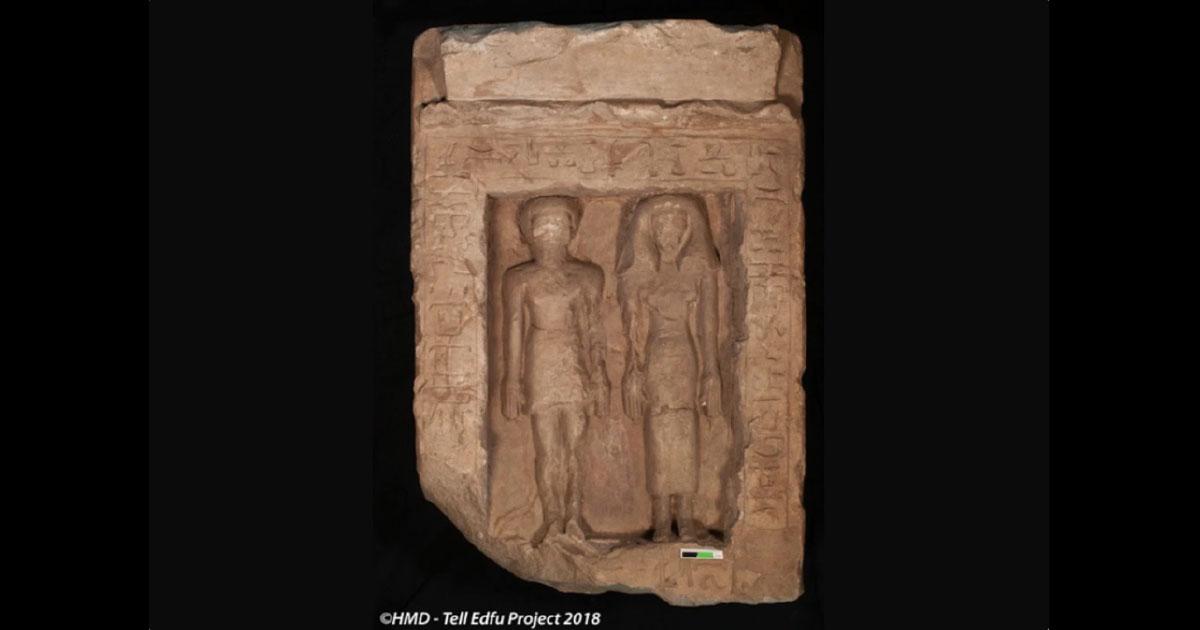
Ancient Egyptian Carving of Couple Defaced in Revenge Attack to Deny Them a Happy Afterlife
Ancient Egyptian beliefs about the afterlife shaped every aspect of their culture and society. A find in a 3,500-year-old shrine is throwing new light on the beliefs of provincial Egyptians. Experts found a limestone carving of a couple that had been deliberately defaced. This was not a result of random vandalism but was an act of deliberate revenge which sought to deny the couple a happy afterlife.
The discovery was made by the ‘Tell Edfu Project which is ‘’sponsored by the Oriental Institute at the University of Chicago’’ reports LiveScience. This is a project that has been excavating what was once an important provincial city from the Pharaonic period to the Roman Empire in Upper Egypt. The 6-hectare site is renowned for its well-preserved Temple of Horus built by the Ptolemies and a small step pyramid. The project, which began in 2001, had provided many new insights into Ancient Egyptians over a period of two millennia.
The Shrine in the Villa
The find was made in a villa that once measured 3,960 square feet (1000 meters), along with some papyri and a statuette. Inside the ruins a team of archaeologists found a limestone carving in a household shrine, which would have been used in the worship of the owner’s ancestors. The carving was badly damaged, and it appeared to represent a man and a woman. The hieroglyphs that once named the couple were too badly damaged to read fully. It appeared that the damage was an intentional act of vandalism and not as a result of time, disaster, or accident.

View (from the East) of the main columned hall of the early 18th Dynasty urban villa discovered at Tell Edfu. Credit: Tell Edfu Project
The Damaged Carving
The limestone relief once apparently showed a couple standing next to each other, but it is impossible to make out their faces. The hieroglyphs that once identified the couple’ names, status and role in society had been deliberately scratched from the carving. Whoever had damaged the carving sought to obliterate the memory of the dead couple. However, they did not totally succeed as experts have been able to read the words ‘Major’ a reference to the male figure and the symbols for ‘noble woman’. The name of the male in the relief could have been ‘Juf’ but this could also refer to the name of the carver or the scribe who composed the hieroglyphs.
Similar attacks on memorials to the dead are not unknown in Egypt. LiveScience reports that Nadine Moeller the director of the project, that erasing the memory of the dead would ‘’obliterate their existence in the afterlife". In ancient Egyptian belief, the memory of the dead had to be kept alive by the living or else the deceased would suffer in the afterlife. This is a belief that is still common in many traditional cultures to this day.
The carving was probably once inscribed with spells and charms that were designed to help the dead in the journey to the afterlife and when their souls were judged by the god of the underworld. These spells were also essential for the wellbeing of the dead. According to the Vintage News ‘’the descendants might have intoned the names and spells inscribed on the stela of their loved ones to ensure their magic remained strong for perhaps hundreds of years after their passing’’. These spells were recited so that the dead ancestors could have everything that they needed in the afterlife, such as food and drink. The Egyptians believed that the wellbeing of the dead was dependent on the living. For example, they needed to perform regular sacrifices and prayers for their ancestor’s wellbeing in the afterlife.
- Tomb Curses of Ancient Egypt: Magical Incantations of the Dead
- Ancient Witchcraft and the Spell of the Pella Curse Tablet
- Damnation of Memory and the Efforts to Erase the Condemned from History

Ancient Egyptian stela with a curse inscription from the Third Intermediate Period (1070-653 BC), Brooklyn Museum (Peter Roan / Flickr)
An Act of Revenge
This belief is key to understanding the probable reasons for the defacing of the limestone carving. The disfiguring of the stone work was not a mindless act of vandalism but a premediated act of revenge. By damaging the representations of the deceased, they were destroying not only their memory but also their descendants’ ability to help them in the afterlife, eventually resulting in their souls or ‘Ka’ disappearing.
The discovery of the damaged memorial is showing experts that life and death were not separate realms as in the modern world but were linked and interdependent in provincial ancient Egypt. It also indicates that in household shrines, families continued to care for the souls of their ancestors and that the deceased were very much part of everyday life.
Top image: Limestone stela showing a man and woman standing next to each other, which shows signs of having been defaced. Credit: Tell Edfu Project
By Ed Whelan















